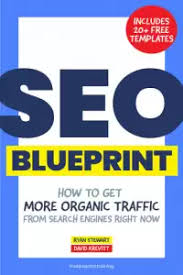In today's digital age, a strong online presence is no longer a luxury; it's a necessity for businesses of all sizes. Search Engine Optimization (SEO) is the cornerstone of this online presence, ensuring your website is easily discoverable by search engines like Google, Bing, and Yahoo. This white paper will provide a comprehensive blueprint for developing and executing a successful SEO strategy.
SEO Blueprint: A Comprehensive White Paper
Introduction
In today's digital age, a strong online presence is no longer a luxury; it's a necessity for businesses of all sizes. Search Engine Optimization (SEO) is the cornerstone of this online presence, ensuring your website is easily discoverable by search engines like Google, Bing, and Yahoo. This white paper will provide a comprehensive blueprint for developing and executing a successful SEO strategy.
1. Keyword Research & Analysis
- Identify Target Keywords: Conduct thorough keyword research to identify relevant keywords and phrases that potential customers are using to search for products or services1 like yours.
- Tools: Google Keyword Planner, Ahrefs, SEMrush, Moz Keyword Explorer
- Keyword Difficulty & Competition Analysis: Assess the difficulty of ranking for each keyword based on competition and search volume.
- Long-Tail Keywords: Focus on long-tail keywords (more specific phrases) for lower competition and higher conversion rates.
- Competitor Analysis: Analyze your competitors' keyword strategies to identify gaps and opportunities.
2. On-Page Optimization
- Website Content:
- High-Quality Content: Create original, informative, and engaging content that addresses user intent and provides value.
- Keyword Placement: Naturally incorporate target keywords throughout your website content (titles, headings, meta descriptions, image alt text, body text).
- Content Structure: Use proper heading tags (H1, H2, H3) to improve readability and search engine crawlability.
- Technical SEO:
- Website Speed: Optimize website speed and performance to improve user experience and search engine rankings.
- Mobile-Friendliness: Ensure your website is mobile-friendly and responsive across all devices.
- HTTPS: Implement HTTPS to enhance security and improve search engine rankings.
- XML Sitemap: Create an XML sitemap to help search engines crawl and index your website.
- Robots.txt: Use robots.txt to instruct search engines on which pages to crawl and index.
3. Off-Page Optimization
- Backlink Building:
- Earn High-Quality Backlinks: Acquire backlinks from reputable and authoritative websites within your industry.
- Guest Blogging: Contribute guest posts to other websites in your niche.
- Broken Link Building: Find and report broken links on other websites and offer your own content as a replacement.
- Local SEO:
- Google My Business: Claim and optimize your Google My Business profile.
- Local Citations: Build citations on local directories (Yelp, Maps, etc.).
- Local Partnerships: Collaborate with local businesses for cross-promotion.
4. Technical SEO
- Website Architecture: Implement a clear and logical website architecture to improve user experience and search engine crawlability.
- URL Structure: Use clean and descriptive URLs that are easy to understand and remember.
- Image Optimization: Optimize images for size and file format to improve page load speed.
- Schema Markup: Implement schema markup to help search engines better understand your website content and display rich snippets in search results.
5. SEO Tracking & Analysis
- Google Search Console: Monitor search traffic, identify indexing issues, and submit your sitemap.
- Google Analytics: Track website traffic, user behavior, and conversion rates.
- SEO Tracking Tools: Utilize tools like Ahrefs, SEMrush, and Moz to track keyword rankings, monitor competitor activity, and identify areas for improvement.
- Regular Audits: Conduct regular SEO audits to identify and address any technical or content issues.
6. Content Marketing
- Blog Posts: Regularly publish high-quality blog posts that provide valuable information to your target audience.
- Infographics: Create visually appealing infographics to share on social media and other platforms.
- Videos: Produce engaging videos to showcase your products or services and build brand awareness.
- Social Media Marketing: Utilize social media platforms to promote your content and engage with your audience.
7. Local SEO
- Google My Business: Claim and optimize your Google My Business profile with accurate and up-to-date information.
- Local Citations: Build citations on local directories (Yelp, Maps, etc.) to improve your local search visibility.
- Local Partnerships: Collaborate with other local businesses for cross-promotion and referral opportunities.
8. E-commerce SEO
- Product Page Optimization: Optimize product pages with relevant keywords, high-quality images, and detailed product descriptions.
- Internal Linking: Implement internal linking to connect related products and improve user experience.
- Site Search Optimization: Optimize your website's search functionality to help users easily find what they're looking for.
9. Mobile SEO
- Mobile-First Indexing: Ensure your website is mobile-friendly and optimized for Google's mobile-first indexing.
- Accelerated Mobile Pages (AMP): Implement AMP to improve page load speed on mobile devices.
- Mobile-Specific Content: Create content that is specifically designed for mobile users.
10. International SEO
- Target Specific Countries: If you're targeting international markets, ensure your website is localized for each country.
- Translate Content: Translate your website content into the appropriate languages.
- Use Country-Specific TLDs: Consider using country-specific top-level domains (e.g., .co.uk, .de) for international markets.
Conclusion
SEO is an ongoing process that requires continuous effort and adaptation. By following this comprehensive blueprint and consistently implementing best practices, you can improve your website's search engine rankings, attract more organic traffic, and achieve your business goals. Contact keencomputer.com for details - A leader in Digital Transformtion and Artificial Intelligence.
References
- Books:
- "The Art of SEO" by Eric Enge, Stephan Spencer, Jessie Stric
